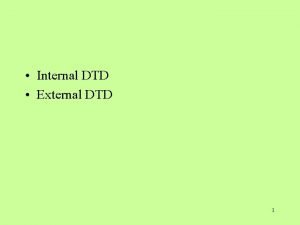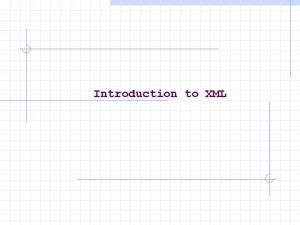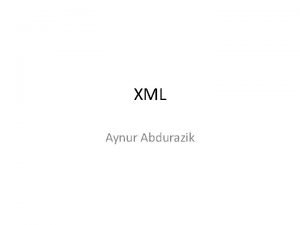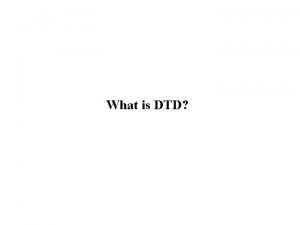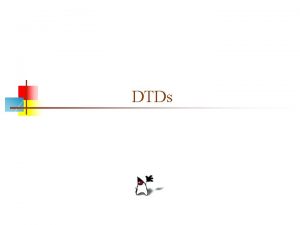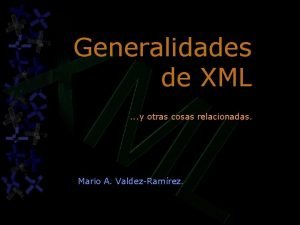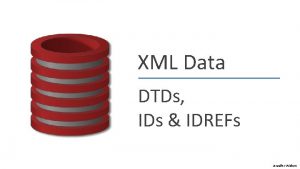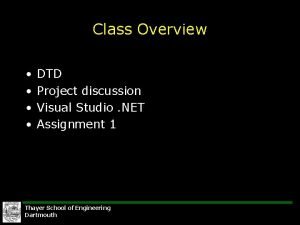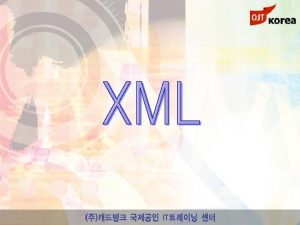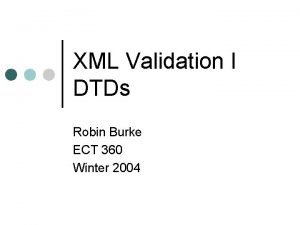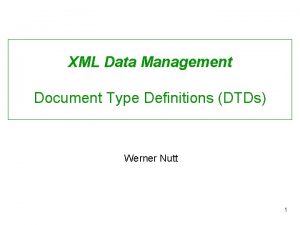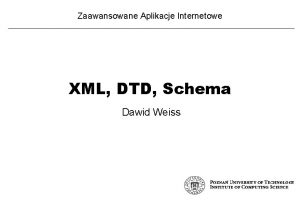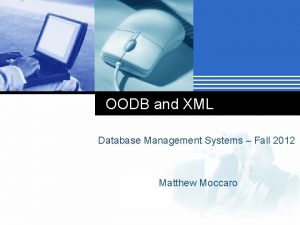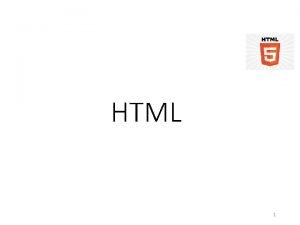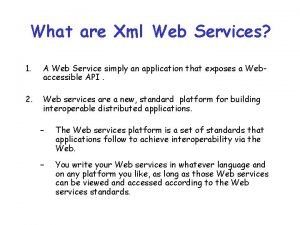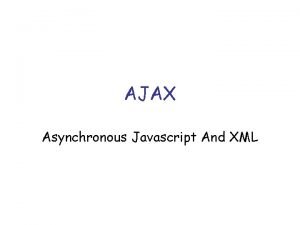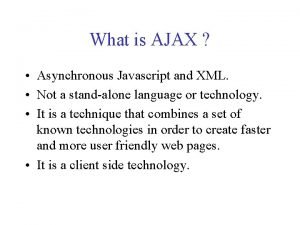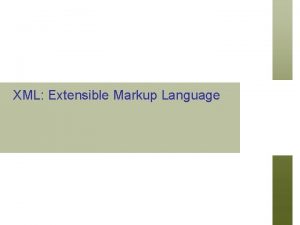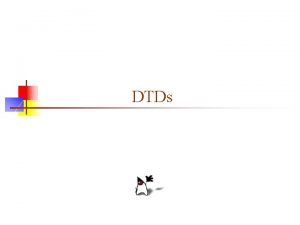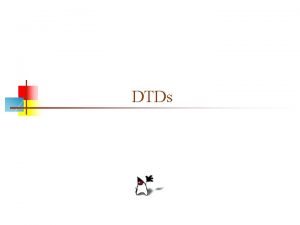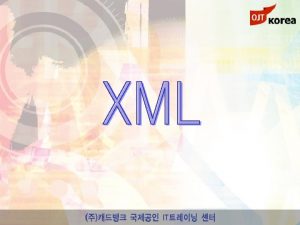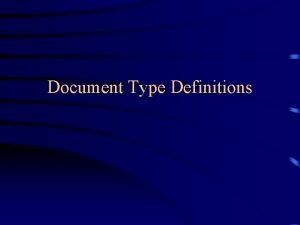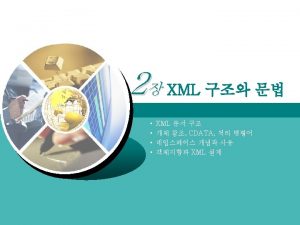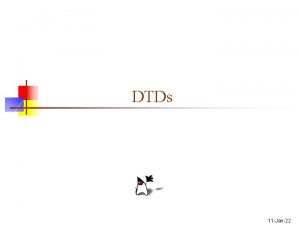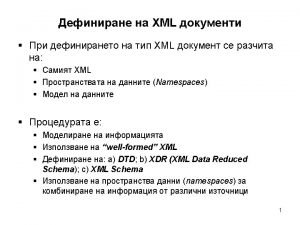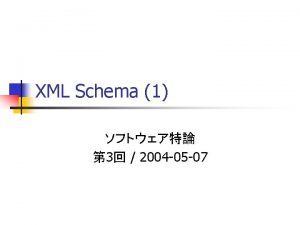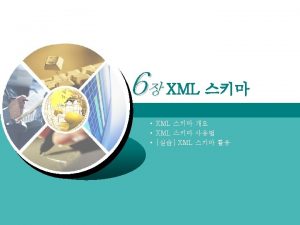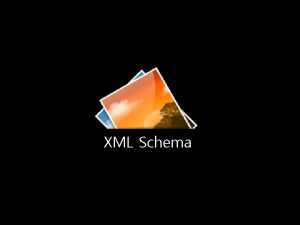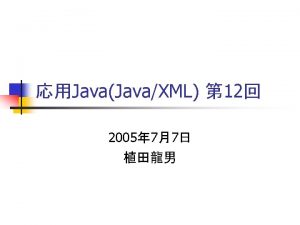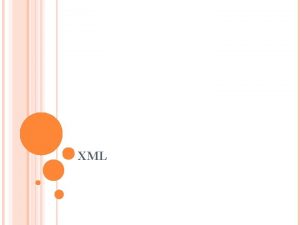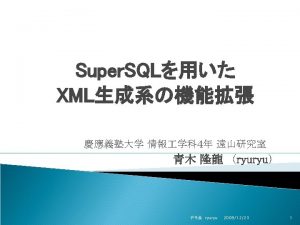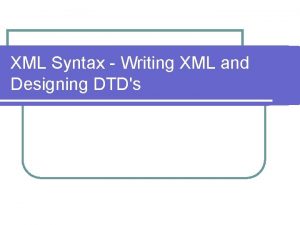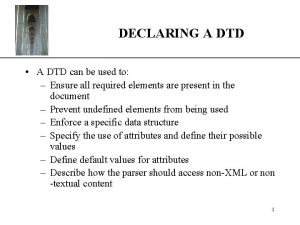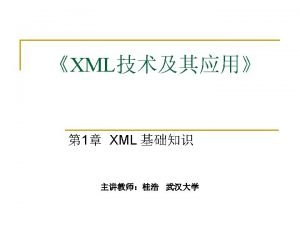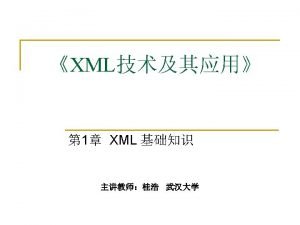DTDs XML and DTDs n A DTD Document


























- Slides: 26

DTDs

XML and DTDs n A DTD (Document Type Definition) describes the structure of one or more XML documents. Specifically, a DTD describes: n n n Elements Attributes, and Entities (We will discuss each of these in turn) An XML document is well-structured if it follows certain simple syntactic rules An XML document is valid if it also specifies and conforms to a DTD (or some other type of schema) 2

Why DTDs? n XML documents are designed to be processed by computer programs n n If you can put just any tags in an XML document, it’s very hard to write a program that knows how to process the tags A DTD specifies what tags may occur, when they may occur, and what attributes they may (or must) have A DTD allows the XML document to be verified (shown to be legal) A DTD that is shared across groups allows the groups to produce consistent XML documents 3

Parsers n An XML parser is an API that reads the content of an XML document n n Currently popular APIs are DOM (Document Object Model) and SAX (Simple API for XML) A validating parser is an XML parser that compares the XML document to a DTD and reports any errors n Most browsers don’t use validating parsers 4

An XML example <novel> <foreword> <paragraph>This is the great American novel. </ paragraph> </foreword> <chapter number="1"> <paragraph>It was a dark and stormy night. </paragraph> <paragraph>Suddenly, a shot rang out!</paragraph> </chapter> </novel> • An XML document contains (and the DTD describes): • • • Elements, such as novel and paragraph, consisting of tags and content Attributes, such as number="1", consisting of a name and a value Entities (not used in this example) 5

A DTD example <!DOCTYPE novel [ <!ELEMENT novel (foreword, chapter+)> <!ELEMENT foreword (paragraph+)> <!ELEMENT chapter (paragraph+)> <!ELEMENT paragraph (#PCDATA)> <!ATTLIST chapter number CDATA #REQUIRED> ]> n A novel consists of a foreword and one or more chapters, in that order n n Each chapter must have a number attribute A foreword consists of one or more paragraphs A chapter also consists of one or more paragraphs A paragraph consists of parsed character data (text that cannot contain any other elements) 6

ELEMENT descriptions n Suffixes: ? + * n foreword? chapter+ appendix* Separators , | n optional one or more zero or more both, in order or foreword? , chapter+ section|chapter grouping (section|chapter)+ Grouping () 7

Elements without children n The syntax is <!ELEMENT name category> n n The name is the element name used in start and end tags The category may be EMPTY: n n In the DTD: <!ELEMENT br EMPTY> In the XML: </br> or just In the XML, an empty element may not have any content between the start tag and the end tag An empty element may (and usually does) have attributes 8

Elements with unstructured children n The syntax is <!ELEMENT name category> n The category may be ANY n n n This indicates that any content--character data, elements, even undeclared elements--may be used Since the whole point of using a DTD is to define the structure of a document, ANY should be avoided wherever possible The category may be (#PCDATA), indicating that only character data may be used n n n In the DTD: <!ELEMENT paragraph (#PCDATA)> In the XML: <paragraph>A shot rang out!</paragraph> The parentheses are required! Note: In (#PCDATA), whitespace is kept exactly as entered Elements may not be used within parsed character data Entities are character data, and may be used 9

Elements with children n A category may describe one or more children: n n n n <!ELEMENT novel (foreword, chapter+)> Parentheses are required, even if there is only one child A space must precede the opening parenthesis Commas (, ) between elements mean that all children must appear, and must be in the order specified “|” separators means any one child may be used All child elements must themselves be declared Children may have children Parentheses can be used for grouping: <!ELEMENT novel (foreword, (chapter+|section+))> 10

Elements with mixed content n n #PCDATA describes elements with only character data #PCDATA can be used in an “or” grouping: n n n <!ELEMENT note (#PCDATA|message)*> This is called mixed content Certain (rather severe) restrictions apply: n n n #PCDATA must be first The separators must be “|” The group must be starred (meaning zero or more) 11

Names and namespaces n All names of elements, attributes, and entities, in both the DTD and the XML, are formed as follows: n n n The name must begin with a letter or underscore The name may contain only letters, digits, dots, hyphens, underscores, and colons (and, foreign languages, combining characters and extenders) The DTD doesn’t know about namespaces--as far as it knows, a colon is just part of a name n The following are different (and both legal): n n n <!ELEMENT chapter (paragraph+)> <!ELEMENT my. Book: chapter (my. Book: paragraph+)> Avoid colons in names, except to indicate namespaces 12

An expanded DTD example n <!DOCTYPE novel [ <!ELEMENT novel (foreword, chapter+, biography? , critical. Essay*)> <!ELEMENT foreword (paragraph+)> <!ELEMENT chapter (section+|paragraph+)> <!ELEMENT section (paragraph+)> <!ELEMENT biography(paragraph+)> <!ELEMENT critical. Essay (section+)> <!ELEMENT paragraph (#PCDATA)> ]> 13

Attributes and entities n In addition to elements, a DTD may declare attributes and entities n n An attribute describes information that can be put within the start tag of an element n n n This slide shows examples; we will discuss each in detail In XML: <dog name="Spot" age="3"></dog> In DTD: <!ATTLIST dog name CDATA #REQUIRED age CDATA #IMPLIED > An entity describes text to be substituted n In XML: ©right; In the DTD: <!ENTITY copyright "Copyright Dr. Dave"> 14

Attributes n The format of an attribute is: <!ATTLIST element-name type requirement> where the name-type-requirement may be repeated as many times as desired n n n Note that only spaces separate the parts, so careful counting is essential The element-name tells which element may have these attributes The name is the name of the attribute Each element has a type, such as CDATA (character data) Each element may be required, optional, or “fixed” In the XML, attributes may occur in any order 15

Important attribute types n n There are ten attribute types These are the most important ones: n n n CDATA The value is character data (man|woman|child) The value is one from this list ID The value is a unique identifier n n ID values must be legal XML names and must be unique within the document NMTOKEN n n The value is a legal XML name This is sometimes used to disallow whitespace in the name It also disallows numbers, since an XML name cannot begin with a digit 16

Less important attribute types n n n n IDREFS NMTOKENS ENTITY ENTITIES NOTATION xml: The ID of another element A list of other IDs A list of valid XML names An entity A list of entities A notation A predefined XML value 17

Requirements n Recall that an attribute has the form <!ATTLIST element-name type requirement> n The requirement is one of: n A default value, enclosed in quotes n n #REQUIRED n n The attribute must be present #IMPLIED n n Example: <!ATTLIST professor degree CDATA "Ph. D"> The attribute is optional #FIXED "value" n n The attribute always has the given value If specified in the XML, the same value must be used 18

Entities n n There are exactly five predefined entities: < , > , & , " , and ' Additional entities can be defined in the DTD: <!ENTITY copyright "Copyright Dr. Dave"> n Entities can be defined in another document: <!ENTITY copyright SYSTEM "My. URI"> n Example of use in the XML: This document is ©right; 2002. • • Entities are a way to include fixed text (sometimes called “boilerplate”) Entities should not be confused with character references, which are numerical values between & and # • Example: &233#; or &x. E 9#; to indicate the character é 19

Another example: XML <? xml version="1. 0"? > <!DOCTYPE weather. Report SYSTEM "http: //www. mysite. com/mydoc. dtd"> <weather. Report> <date>05/29/2002</date> <location> <city>Philadelphia</city>, <state>PA</state> <country>USA</country> </location> <temperature-range> <high scale="F">84</high> <low scale="F">51</low> </temperature-range> </weather. Report> 20

The DTD for this example <!ELEMENT weather. Report (date, location, temperature-range)> <!ELEMENT date (#PCDATA)> <!ELEMENT location (city, state, country)> <!ELEMENT city (#PCDATA)> <!ELEMENT state (#PCDATA)> <!ELEMENT country (#PCDATA)> <!ELEMENT temperature-range ((low, high)|(high, low))> <!ELEMENT low (#PCDATA)> <!ELEMENT high (#PCDATA)> <!ATTLIST low scale (C|F) #REQUIRED> <!ATTLIST high scale (C|F) #REQUIRED> 21

Inline DTDs n If a DTD is used only by a single XML document, it can be put directly in that document: <? xml version="1. 0"> <!DOCTYPE my. Root. Element [ <!-- DTD content goes here --> ]> <my. Root. Element> <!-- XML content goes here --> </my. Root. Element> n An inline DTD can be used only by the document in which it occurs 22

External DTDs n An external DTD (a DTD that is a separate document) is declared with a SYSTEM or a PUBLIC command: n n n <!DOCTYPE my. Root. Element SYSTEM "http: //www. mysite. com/mydoc. dtd"> The name that appears after DOCTYPE (in this example, my. Root. Element) must match the name of the XML document’s root element Use SYSTEM for external DTDs that you define yourself, and use PUBLIC for official, published DTDs External DTDs can only be referenced with a URL The file extension for an external DTD is. dtd External DTDs are almost always preferable to inline DTDs, since they can be used by more than one document 23

Limitations of DTDs n DTDs are a very weak specification language n n You can’t put any restrictions on element contents It’s difficult to specify: n n All the children must occur, but may be in any order This element must occur a certain number of times There are only ten data types for attribute values But most of all: DTDs aren’t written in XML! n n If you want to do any validation, you need one parser for the XML and another for the DTD This makes XML parsing harder than it needs to be There are newer and more powerful technologies: XML Schemas and RELAX NG However, DTDs are still very much in use 24

Validators n Opera 5 and Internet Explorer 5 can validate your XML against an internal DTD n n IE provides (slightly) better error messages Opera apparently just ignores external DTDs IE considers an external DTD to be an error j. Edit (my favorite editor) with the XML plugin will check for well-structuredness and (if the DTD is inline) will validate your XML each time you do a Save n http: //www. jedit. org/ 25

The End 26
 External dtd
External dtd Document object model
Document object model Dtd atributos
Dtd atributos Carrying value formula
Carrying value formula 자바스크립트 쿠키
자바스크립트 쿠키 Abdurazik
Abdurazik Dtd defines
Dtd defines Dtd in web technology
Dtd in web technology Dtd
Dtd Dtd
Dtd Dtd idrefs
Dtd idrefs Dtd visual studio
Dtd visual studio Dtd vs schema
Dtd vs schema Adbs
Adbs Dtd
Dtd Dtd
Dtd Dtd
Dtd Dtd
Dtd Zaawansowane aplikacje internetowe
Zaawansowane aplikacje internetowe Whats dtd
Whats dtd Oodb and xml database
Oodb and xml database Relationship between html sgml and xml
Relationship between html sgml and xml Xml webservice
Xml webservice Asynchronous javascript and xml
Asynchronous javascript and xml Asynchronous javascript and xml
Asynchronous javascript and xml Data integration with xml and semantic web technologies
Data integration with xml and semantic web technologies And xml
And xml
